Manitoba Exploration & Development Review

• Alamos Gold increases 2024 exploration budget for Lynn Lake project
• MPDA Exploration Discovered now available
• MPDA Reconciliation Gala charts partnerships in Manitoba's mineral sector
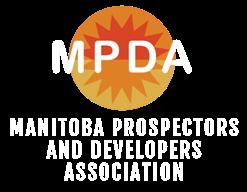




• Alamos Gold increases 2024 exploration budget for Lynn Lake project
• MPDA Exploration Discovered now available
• MPDA Reconciliation Gala charts partnerships in Manitoba's mineral sector



We work with mineral and mining businesses in Manitoba to help identify significant energy-saving opportunities.
Our programs offer financial incentives and technical support for various industrial technologies including:
• Compressed air
• Pumps, fans, and blowers
• VFDs for fans and pumps
• Industrial refrigeration
• Waste heat recovery
• Steam and water boiler systems
• Other process systems
rights reserved. The contents of this publication may not be reproduced by any means, in whole or in part, without the prior written consent of the publisher.
Publications mail agreement #40934510 Return undeliverable
Canadian addresses to: DEL Communications Inc. Suite 300, 6 Roslyn Road Winnipeg, MB R3L 0G5
All mining and exploration property information presented in this publication is prepared by DEL Communications Inc. Descriptions of, or references to, mining and exploration properties within this publication do not imply endorsement of such properties by the Manitoba Prospectors and Developers Association Inc. (MPDA). The MPDA makes no warranty as to the completeness, timeliness or accuracy of any of the data included in this publication. All information conveyed by this publication is provided to readers for their own evaluation of such information. This publication could include technical inaccuracies or typographical errors. Any reliance on the information contained in this publication is solely at the reader’s own risk. MPDA specifically disclaims all warranties, express implied or otherwise, including without limitation, all warranties of merchantability and fitness for a particular purpose. In no event will MPDA be liable for any direct, indirect, special or consequential damages, or any other damages, whatsoever, for any use of, or reliance on, information provided by this publication, including without limitation any lost opportunity or profits, even if MPDA is expressly advised of, or otherwise aware of, the possibility of such damages, whether in an action of contract, negligence, tort or otherwise.




Manitoba is positioned for growth in green technologies, with a significant opportunity lying in southern Manitoba. The province is home to vast deposits of some of the highest purity silica sand, a critical component for emerging technologies. According to the draft Manitoba Mineral Brochure, these silica deposits, boasting purity levels exceeding 99.5 per cent, stretch from near the Ontario border east to near Brandon in the west, and south to the U.S. border. The area of the Winnipeg Formation Williston combined is greater than 1.6 million hectares.
Silica is currently fetching more than double the price of potash on the open market ($640 versus $294 USD per tonne). The global High Purity Quartz market is forecast to reach $703.4 million by 2025, after growing at a compound annual growth rate (CAGR) of 6.5 per cent from 2020 to 2025. The growing semiconductor industry, alongside rising demand for technical innovations and electronics industry, is expected to boost the global highpurity quartz industry.
However, 2023 was a challenging year
for most other commodities. Prices for many metals have collapsed, and the continued contraction of the global economy has reduced the availability of capital. This has exacerbated financing challenges, as noted in the PDAC Mineral Financial Report 2024.
A new Critical Mineral Strategy is being developed under the leadership of Premier Wab Kinew’s NDP government, which is strongly supporting the sector. Manitoba is home to 29 of the 31 minerals on Canada’s 2021 Critical Minerals List, including lithium, graphite, nickel, cobalt, copper, and rare earth elements. These six minerals are recognized as having the greatest opportunity to spur economic growth and fuel domestic supply chains. Additionally, Manitoba hosts highgrade silica sand, crucial for solar panel production.
The Manitoba Prospectors and Developers Association (MPDA) is a member-driven organization and the most active mineral association in the province. It plays a key role in raising public awareness about the sector
and fostering engagement through monthly speaker events, training courses, and high-profile initiatives like the Mineral Sector Indigenous Reconciliation Gala. After a five-year hiatus, the MPDA has reinstated Manitoba’s Minerals Week, joining every other province and territory in Canada in this important event. We have a very strong and experienced policy team which have been invited to provide comments on the provincial budget, mineral strategy, park designations, and federal initiatives.
Founded in 1982, the MPDA is a nonprofit organization representing over 124 members involved in mineral exploration and development across Manitoba. It is the voice of small businesses in the exploration, supply, and service sectors.
The MPDA is committed to building a robust and inclusive critical mineral sector in Manitoba. With continued collaboration and innovation, Manitoba’s mineral industry is poised to be a key contributor to both the provincial economy and Canada’s broader critical mineral supply chain.

On behalf of the Government of Manitoba, I am pleased to provide a message of welcome for the 2024 Manitoba Prospectors and Developers magazine.
Manitoba is well placed to be a leader in the low-carbon economy and sustainable critical mineral extraction. Our government takes this opportunity seriously and we are committed to growing Manitoba's critical mineral industry in a responsible way that will benefit everyone in our province. We have 29 of the 31 critical minerals
right here in Manitoba, and the expertise to extract them in an environmentally responsible and sustainable way, while respecting treaty rights and working in a nationto-nation relationship with First Nations, Metis, and Inuit governments.
Our government is developing a real critical mineral strategy that creates good Manitoba jobs for Manitobans and sustainable economic growth across our province, particularly in the north. As we do this work, we will continue to partner with First Nations,
At Hudbay, our mission extends beyond mining — we’re shaping a more sustainable future.

companies, and advocates who share our goal to grow Manitoba's low-carbon economy and create good jobs. Together, we can extract Manitoba's valuable critical minerals and get those minerals to market in a safe and sustainable way.

Sincerely,
The Honourable Wab Kinew, Premier of Manitoba ✖


Our company-wide commitments include reducing greenhouse gas (GHG) emissions by 50% by 2030 and achieving net-zero by 2050.
Our Manitoba Business Unit is leading the charge in sustainable practices, implementing innovations like batteryelectric equipment and achieving significant reductions in emissions and freshwater usage.
With nearly 100% of our total indirect energy in Manitoba coming from renewable sources, we continue to pioneer responsible mining, evaluating reprocessing tailings to recover critical minerals, and reducing our environmental footprint.
Through these efforts, we ensure that our operations contribute to a greener economy while safeguarding the communities and environments where we operate.
Minister of Economic Development, Investment, Trade and Natural Resources, and
Minister of Indigenous Economic Development and Municipal and Northern Relations
As Ministers of Economic Development, Investment, Trade, and Natural Resources, and Indigenous Economic Development and Municipal and Northern Relations, we are honoured to jointly update the Manitoba Prospectors and Developers Association on our commitment to mining and exploration initiatives in our province.
This is an incredibly exciting time for this industry in Manitoba, with the province continuing to see historic exploration spending. We are pleased to report that industry exploration has hit yet another record high, with $197.8 million spent in 2023.
In March this year, alongside the Honourable Premier Wab Kinew, we had the privilege of representing our province at the annual Prospectors & Developers Association of Canada (PDAC) conference in Toronto. We reaffirmed Manitoba’s commitment to positioning Manitoba as a leading destination for new mining ventures, strengthening our partnerships with Indigenous communities across the province, and maintaining the robust environmental, social, and governance standards expected by the industry and the people of this great province. We have continued to foster relationship and partnership
agreements between Indigenous Nations and project proponents. It is paramount that proponents undertake engagement with Indigenous Nations early in the planning phase to develop positive relationships, adjust plans to address concerns, and form mutually beneficial partnerships.
During our time at PDAC, we outlined Manitoba’s competitive advantages in the growing critical mineral markets, with 30 of the 34 identified by the federal government occurring in our province. We are currently working with Indigenous communities, industry partners, and other stakeholders to develop a new Critical Minerals Strategy to align the province with our key global partners and tap into Manitoba's vast mineral potential. Expanding production of these commodities will position


Manitoba in growing supply chains for clean technologies, renewable energy, and electrification.
The Manitoba government is committed to fostering an environment that promotes responsible mineral development and supports the growth and success of the mining sector. We recognize the enormous importance of our mineral resources and their potential to spur economic growth for Manitobans. By making strategic investments and continuing to foster meaningful partnerships with Indigenous communities and organizations like the Manitoba Prospectors and Developers Association, we are confident we can unlock the full potential of Manitoba's mineral wealth while preserving our natural heritage for future generations.



The Manitoba Prospectors and Developers Association (MPDA) is an advocacy group focused on improving the state of mineral exploration in Manitoba. MPDA is committed to supporting the minerals sector and furthering the goals of companies and individuals working within it. Our collective objective is to develop productive and efficient ways of working with our industry and community partners so that Manitoba becomes one of the most attractive places to invest in the mineral business.
Join the leading voice of the mineral exploration and development sector in Manitoba!

Becoming a member is a great way to network, learn about key topics affecting the industry, and help shape the future of Manitoba’s mineral exploration and extraction industries. Membership unlocks access to MPDA events, networking, and short courses. The work of the association, including its advocacy activities and programs, is funded solely from revenues derived from member fees and from our events.
Visit www.mpda.ca/membership-drive-2024/ to join today. Student, individual, and corporate memberships are available.

Date: Tuesday, February 11, 2025
Location: TBD
Join us for the Manitoba Prospectors and Developers Association's Annual General Meeting (AGM). This is an opportunity for members to help shape the direction of MPDA. The meeting will also include the election of the new board of directors. Your voice matters—be part of the conversation!
Date: Thursday, April 10, 2025
Location: Assiniboia Downs, Winnipeg
Join us all day celebrating reconciliation efforts in Manitoba.

Date: August 2025
Location: TBD
Tee off with us at the MPDA Annual Golf Tournament! This event brings together members, industry professionals, and community partners. This tournament offers something for everyone, with prizes, a banquet, and opportunities to network.
Stay tuned for more events throughout the year. For a complete list and registration details, visit www.mpda.ca.
MPDA provides different event sponsorships for key events like the Reconciliation Gala and Golf Tournament. These opportunities offer exposure and engagement with industry professionals and members. ✖

The 2024 MPDA Golf Tournament brought together industry professionals for a day of networking and friendly competition. Held at Kingswood Golf Course, the event welcomed MPDA members, sponsors, and supporters all ready to enjoy a day on the green.
The tournament kicked off with a shotgun start, and players quickly embraced the challenges of the course. Throughout the day, participants took part in fun contests, including the longest drive and closest-to-the-pin competitions, adding extra excitement to the rounds.

After an intense yet enjoyable round of golf, everyone gathered for the banquet and awards ceremony. It was a wonderful way to unwind and celebrate the achievements of the day. Prizes were awarded to top performers, with prizes going to best players and teams.
The tournament’s proceeds will support MPDA’s ongoing initiatives, making the day not just fun, but also meaningful for the entire community. It was an event to remember! ✖




The 2024 Reconciliation Gala was an evening of celebration that brought together industry leaders, Indigenous communities, government officials, and stakeholders. Held on March 21st at Assiniboia Downs, this annual event celebrates reconciliation efforts and creates partnerships in Manitoba’s mining sector.
This year’s keynote speaker was Phillip “Jerry” Asp, one of Western Canada’s most prominent Indigenous leaders. With decades of experience advocating for Indigenous rights and economic development in the
mining industry, Asp shows a drive to improve the economic development of his home community and other Indigenous communities across the country.
The highlight of the evening was the presentation of the Reconciliation Award. This year, the Partners in Development Award was given to T2 Metals and the Kiciwapa Cree Nation - Sherridon Community. The award recognized their partnership in advancing sustainable development projects.


The 2024 Reconciliation Gala was a reminder of the ongoing work needed to achieve reconciliation and the importance of partnerships in this journey. MPDA remains dedicated to facilitating dialogue, building connections, and promoting initiatives that support both economic development and the well-being of Indigenous communities across Manitoba.
For more information about MPDA’s initiatives and future events, visit www.mpda.ca. ✖

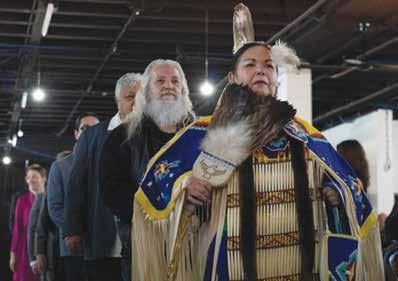



MPDA partnered with iTOTEM Analytics to complete an economic impact study called “Exploration Discovered.”
The report shows the mineral exploration industry is essential to businesses, communities, and people in all corners of the province, helping to ensure a strong and vibrant provincial economy for generations to come.
• Demonstrates the economic impact of mineral exploration across Manitoba;
• Explores the diversity of vendors and their geographic variances;
• Determines economic relationship between Indigenous businesses and mineral exploration; and
• Shows how mineral explorers contribute to local communities.
To learn more visit https://mpda.ca/exploration-discovered/ ✖

By MaryAnn Mihychuk, MSc Geo, president, MPDA
In a recent op-ed, Anne Lindsey raised concerns about potential environmental impacts from mineral extraction in Manitoba, specifically pointing to silica sand projects as examples of potential harm. However, it is essential that we broaden this perspective and do our best to avoid spreading misinformation by acknowledging that Canada has made major contributions to mineral exploration and extraction science.
We can be proud of Canadian innovation, particularly in the critical mineral sector, maintaining some of the best environmental protection measures and governance mechanisms in the world to ensure responsible mineral sector practices across the country.
Modern mineral extraction practices prioritize safety and environmental protection. Advancements in technology, stringent regulations, and sustainable practices contribute to ever improving safety standards. Rigorous environmental impact assessments, conducted by independent qualified experts, identify and mitigate potential risks.
Through close collaboration with scientists, engineers, and environmental specialists, the mineral extraction sector proves itself committed to best practices that balance environmental protection and economic development, especially Indigenous economic development, while supporting global efforts to invest in green technologies and mitigate climate change.

Ranking among the top five countries in the world for mineral production, Canada’s extraction sector plays a crucial role in the nation’s economy. Investing in the critical mineral sector now, as a part of Canada’s shift to a green economy, offers Manitoba a chance to be a leader in this effort, while providing employment opportunities for countless Manitobans, particularly for those living in Indigenous communities, as well as northern and remote communities.
Ongoing collaborations between mineral companies and Indigenous groups demonstrate a mutual understanding of the benefits and economic potential.
Acknowledging advancements in exploration and extraction science, adherence to environmental protection measures, and collaborative efforts with Indigenous communities, Manitoba can navigate toward a sustainable and prosperous future. Recognizing these initiatives is vital and avoiding misleading dogma is fundamental as we collectively work towards a greener, more responsible mining
In conclusion, Manitoba’s critical mineral sector is crucial for a green economy, providing economic opportunities for communities who wouldn’t otherwise have them. We have the opportunity and responsibility to support a transition to a zero-emissions future. ✖
By MaryAnn Mihychuk, MSc Geo, president, MPDA
Originally published as opinion pieces in the Winnipeg Free Press
Cherry-picking environmental issues and denigrating Manitoba’s environment framework may provide good fodder at the door for environmental fundraising campaigns, but in terms of public policy, it is nothing more than gaslighting. The lobbyist for the Wilderness Committee, quoted in the Winnipeg Free Press article “Concerns raised over mining exploration in caribou habitat” (March 13), puts science and professionalism on the back burner.
Manitoba has one of the most rigorous and thorough processes for protecting our environment. So when lobbyists attack mineral exploration using misleading statements, they also attack the fabric of science and professionalism.
Mineral exploration permits in parks, like exploration work planned for Grass River Provincial Park, are only issued after professional biologists at the wildlife branch evaluate the potential effects on wildlife and ensure the project is compatible with the goals of the park.
In this case, the permit requires the diamond drill rig – a unit the size of an ice fishing shack – to be slung by helicopter to the site.
If there are any caribou in the area, the process is immediately cancelled, according to directives embedded in the Wildlife Act and in the Canadian Aviation Regulations.
Mineral exploration is not mining. Calling exploration projects “mining” is deliberately misleading. Early-stage exploration projects generally consist of remote sensing or by walking the ground. Access to mineral dispositions is usually by foot, boat, truck or, more commonly now, by helicopter.
If we look at real data, tracking from March 2018 shows that the Reed caribou local population has remained stable
and was possibly increasing over the nine-year modelling period, averaging about 330 individuals.
Many mining companies actively work to enhance wildlife management within the regions where they operate. An excellent example is Hudbay Minerals’ work with caribou in the Grass River area, as published in their annual sustainability reports.
The paid lobbyist of the Wilderness Committee recently said that a Manitoba exploration company would “bulldoze caribou.”
No one is bulldozing caribou. It is a ridiculous statement. And it does nothing to improve the environmental performance of mineral exploration, mining, or any other development being proposed for our province. In fact, there is good evidence to suggest that these types of projects have virtually no negative impacts on caribou populations.
Manitoba needs mineral exploration projects. Manitoba needs mining. Billions of dollars are left on the table annually because we have not properly developed our mineral endowment. Compared with jurisdictions with similar mineral endowments, Manitoba is losing out on between $4 billion and $6 billion in GDP annually.
In other words, a healthy mineral industry would put an additional income of $5,000 for every man, woman, and child in the province, plus the related taxes at each level of government to pay for health, education, roads, and other services.
And Manitobans, including those working in these industries, care deeply about the environment. That means we have an opportunity, and a responsibility, to show the world how we can develop mineral projects properly.
But first, we must move past the cheap rhetoric and start focusing on real solutions. ✖
Manitoba has one of the most rigorous and thorough processes for protecting our environment. So when lobbyists attack mineral exploration using misleading statements, they also attack the fabric of science and professionalism.



By MaryAnn Mihychuk, MSc Geo, president, MPDA
Originally published as opinion pieces in the Winnipeg Free Press
Beneath Manitobans’ feet lies a treasure trove, ripe and ready for exploration.
Like Windsor is to salt and Saskatchewan to potash, the emergence of green technologies has placed a huge new economic opportunity right beneath the feet of Manitobans.
Since its beginning in the late 1800s, Winnipeg has benefited from being a centre of trade for western Canada, hoping in those early heady days to become “the Chicago of the North.”
Natural resources were always part of the mix. But unlike agriculture, Tyndall Stone, and aggregate, mineral development was generally something that happened far, far away in Manitoba’s north.
Now, all that could change, with green technologies seeking the highest purity silica sand and southern Manitoba hosting massive deposits with silica
values exceeding 99.5 per cent.
When stacked up against Saskatchewan and its potash, Manitoba silica is the clear winner, with our silica sands fetching more than double the price on the open market ($640 versus $300 per tonne).
This resource occurs in two distinct sand units within the 470 million year old Ordovician Winnipeg Formation, which is widespread throughout what is known as the Williston Basin of western Canada.
The Manitoba Critical Mineral Brochure indicates the silica deposit spreads west from the Falcon Lake-Hollow Water edge on the east to near Brandon in the west and south to almost the U.S. border.
Combined, these units span an area greater than 1.6 million hectares – almost four times the 485,000 hectares of potash located in Saskatchewan.

This is the kind of discovery that can change everything for an economy, as it has in Saskatchewan, where BHP recently announced $6.4 billion in spending for phase two of the Jansen potash mine, one of 11 potash mines in the province.
Development on this scale across Manitoba’s silica sand resource area would mean hundreds of millions, if not billions, of dollars in new tax revenues for governments at all levels.
Manitoba’s southern municipalities could balance their budgets and pay back their debts. Manitoba could finally afford a modern health-care system. And decent roads.
And Indigenous communities would have an opportunity to get in on the ground floor for defining how this newly profitable resource should be developed.
A prime example of this type of collaboration is the Canadian Premium

Sand project near Hollow Water First Nation and Peguis First Nation environmental monitors.
Backed by Premier Wab Kinew, this initiative promises environmental and economic benefits for the First Nation, like substantial job creation, environmental oversight, and revenue sharing.
Indigenous communities are pivotal in sustainably unlocking our mineral potential, ensuring that the wealth of resource development is shared equitably.
The economic spinoffs would also be felt across Manitoba.
It could mean thousands of good paying primary industry jobs for young people.
It could also spawn whole new manufacturing and research and development industries by companies wanting to locate next to the resource.
And in the process, it would put an end to our long-standing western Canadian resource envy.
The first step in accomplishing this is for Manitobans to change our relationship with resources. Traditionally, our diverse economy has given us the luxury of saying “No” to projects like this.
But by pivoting our perspective from “NIMBY” (not in my backyard) to “HOME” (harnessing our mineral excellence), we lay the groundwork for economic growth and prosperity for our communities.
While novel for sand extraction, wells are not new resource extraction technology.
Wells are sealed from surface and are highly regulated.
They have long been designed
to prevent mixing materials from different rock layers in the earth.
There are over 12,000 holes in similar rock formations in the Virden/ Waskada area in southwestern Manitoba.
ERCO Worldwide is operating a similar technology near Virden to extract salt brine. And PadCom near Russell is using similar technology to extract potash.
Many of these wells cross saline and freshwater aquifers to reach their intended target, without failure. The province is not aware of any groundwater contamination from these wells.
Manitoba’s environmental licensing legislation is among the best in the world. It is a robust, science-based, environment licensing process that provides significant opportunities for public engagement.
Where there are environmental questions, tests can be done to ensure no adverse effects are caused by a project.

Our science-based licensing process not only facilitates significant public engagement but also ensures that environmental safeguards are in place to prevent any potential adverse effects from mineral projects.
Developing projects in Manitoba using our policy framework ensures these projects will be developed safely.
It also allows us to continue to develop environmental best practices that can be provided to others around the world where environmental practices are not always so robust.
These practices set a standard that can be provided to other regions where oversight may not be as stringent.
This dual focus positions Manitoba as the keystone in Canada’s transition to a green economy, while engineering an economic win-win.
As we unlock the door to a sustainable future, we also open the treasure chest of prosperity.
Opportunity is knocking. Will we open the door? ✖


This month marks a significant milestone for our company. We are thrilled to celebrate 20 years of dedication, innovation, and unwavering commitment to excellence. As we reflect on our past achievements and look toward the future, we are filled with gratitude for the incredible journey we've shared together.
Over the past two decades, Cyr Drilling has evolved from a humble beginning into a leader in mineral exploration sector. What started as a vision has transformed into a thriving enterprise, thanks to the passion, hard work, and dedication of every member of our team.
Throughout the years, we have faced
numerous challenges and overcome them with resilience and determination. Each obstacle has been an opportunity for growth, pushing us to innovate and adapt in an ever-changing landscape. Our ability to embrace change and embrace new technologies has been instrumental in our success.
Our valued clients and partners are the heart of our success. With over 230 contracts and over 1.5 million metres drilled, your trust and support have been the driving force behind everything we do. We are deeply grateful for the opportunity to serve you and for the relationships we've built along the way.
As we celebrate this milestone, we also

would like to recognize the incredible individuals who have contributed to our success. From our talented employees to our visionary leaders, each person has played a vital role in shaping who we are today. Together, we have created a culture of excellence, collaboration, and innovation that sets us apart.
Looking ahead, we are excited about the possibilities that the future holds. We are confident that the next 20 years will be even more remarkable than the last. ✖
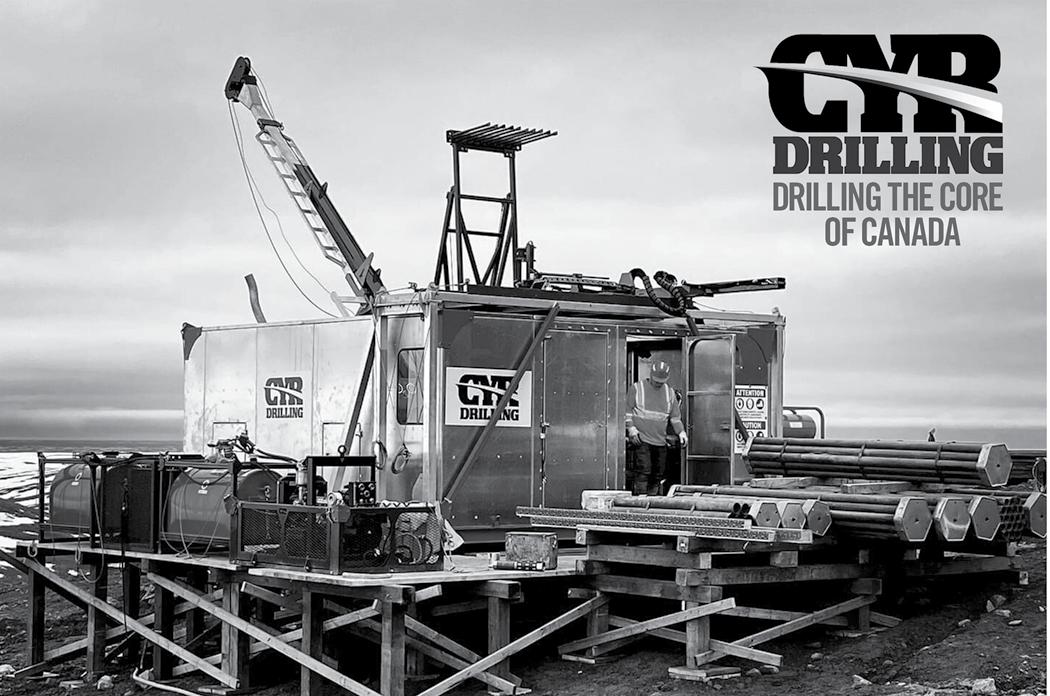

By Victoria Martinez
The Saskatchewan Research Council (SRC) provides comprehensive services for science, technology development and commercialization, and environmental solutions for the mining and energy industries. Although geographic in name, SRC’s service area extends far beyond the province.
SRC’s labs and facilities are based in Saskatoon, Sask., but companies from all over test their technologies and send their samples to this sciencebased powerhouse on the prairies.
With more than 77 years of experience to draw from, the organization serves 1,600-plus clients in 22 countries around the world.
Offering a robust suite of in-house expertise, SRC integrates services across sectors to provide unique, sustainable solutions to meet its clients’ needs. This is especially important for mining, where opportunities for innovative technology adoption can provide companies a unique edge in a field where traditional
methods are engrained in operations.
“People often think that innovation is just new technologies, but it’s also about unique applications of technologies or integrating them in unique ways,” said Lucinda Wood, manager of SRC's business development team. “From exploration to closure, there are opportunities to integrate digitization in mining, like automation, sensors, and data management for example.”

The increased need for critical metals – like rare earths and lithium – for next generation technologies (like electric vehicles) means that mining is a key part of a sustainable energy transition.
Because SRC offers services for every stage of a mining project –from exploration to closure – for a wide range of minerals, it can help companies develop comprehensive approaches to their own sustainability efforts.
“Mining itself needs to be sustainable,” Wood said. “So, we’re helping mining companies think about different solutions, such as mining or processing less waste material, that could help them achieve their goals.”
SRC can be a support to a mining



project throughout its life cycle to consider sustainability at every stage. For instance, a mining client who is doing analysis at SRC’s geochemistry laboratory may also want to look at new processing technologies. They may need to develop climate change adaptation plans as part of a netzero strategy and want to engage with communities to participate in implementing this strategy.
Expanding services and facilities to meet industry needs
Uranium, potash, and niche commodities require different approaches to technology and process integration to succeed, and SRC has a breadth of facilities to meet their diverse needs. SRC runs several world-class testing and piloting facilities, which contribute insight and expertise from exploration
and assaying through to mine closure and decommissioning.
With every project, SRC’s services also balance and optimize client social, economic, and environmental goals. Technological and sustainability solutions go hand in hand with developing economic growth for business stability and community growth. This level of integration requires knowledge in a variety of sectors and technologies, but also the foresight to see opportunities based on future trends and shifting client needs.
“I think SRC has been very smart at adapting to the changes in the innovation ecosystem and industry needs, and that’s why we’ve been around so long. Business longevity is really hard to achieve, and adaptability is one of the pillars of success,” Wood said.
An agile, adaptable suite of services is a natural outcome of SRC’s strong, long-term relationships with its mining clients.
“There has to be trust, people have to know you,” she said. “On the prairies, relationships are really important because even though our industries are global in scale, there is still a small-town culture of knowing the people you do business with.”
Building on the cross-industry expertise at SRC’s teams and facilities, the organization’s experts look to bolster SRC’s services for the changing needs of mining companies – focusing on a comprehensive approach, with sustainability top of mind.
Learn more about SRC at www.src. sk.ca/mining. ✖
• Geoanalytical testing and automated mineralogy
• Minerals processing testwork and piloting
• Closure planning
• Remediation solutions
• Plant performance diagnostics and optimization
• Air quality monitoring
• Sensor-based sorting characterization and piloting
• Energy assessments, including renewables

Alamos Gold’s Lynn Lake Project is expected to bring long-term value to Manitoba with a 17-year mine life. This includes new economic growth in the northern Manitoba and long-term job opportunities all supported by a longlife project with a low greenhouse gas emission intensity.
The momentum has been building, as evident by the project’s exploration program that has continued to spark the team’s enthusiasm in the past year. They see great potential in this large and underexplored greenstone belt that has yet to be realized.
It is why Alamos increased its 2024 exploration budget for the Lynn Lake Project by 65 per cent more than the year prior, now totaling $11.6 million (up from $7 million).
A significant highlight of Alamos’ updated Feasibility Study, published
in 2023, was the 44 per cent boost in the Lynn Lake Project’s Mineral Reserve, up from its 2017 Feasibility Study. This was based on positive exploration results from its Gordon and MacLellan deposits.
The study also showed that the project will be a larger operation, with a higher annual rate of production, a low-cost profile, and an overall more robust operation compared with the 2017 study.
Alamos’ technical team is gearing up to release the results of a study this year, which will incorporate the Burnt Timber and Linkwood satellite deposits into the project. The last results, at the end of 2023, reported that Burnt Timber and Linkwood contained inferred mineral resources totaling 1.6 million ounces grading 1.1 g/t Au (44 mt).
“We see excellent potential for this
to be converted into a smaller, higher quality mineral reserve which could be incorporated into the Lynn Lake Project, given its proximity to the planned mill,” said Scott Parsons, Vice President of Exploration for Alamos Gold. “The results of this study will be another value driver as upside to our 2023 Feasibility Study.”
In addition to drilling, the Alamos team is currently utilizing a combination of geological, geophysical, and geochemical techniques to inform exploration targeting.
Included in this, for example, is 15,500 metres of drilling focused on the conversion of mineral resources to mineral reserves at the Burnt Timber and Linkwood deposits.
The team uses 3D geological models to visualize the gold deposits. These models are constructed by utilizing data collected from drill holes, including interpretation of geological
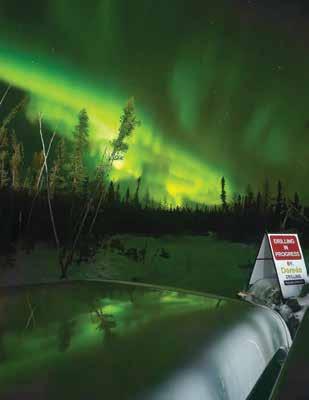
domains, alteration domains, and structural controls. This is used in conjunction with gold assays and multi-element geochemistry to model the distribution of gold within the deposit, which allows for detailed

evaluation of the extent, grade, and economic viability of the mineral deposit.
The team also continues to evaluate and advance a pipeline of prospective
exploration targets within the 58,000-hectare Lynn Lake Project property. This includes evaluating the potential for mineral resources at Maynard, an advanced stage greenfield target.


Parsons notes that this dedication to a robust exploration program is not just unique to Manitoba but is company wide. He and his team have built a broad-based exploration program
all of Alamos’ assets in Canada and Mexico. In fact, Alamos’ global mineral reserves have increased for five consecutive years between 2018 to 2023.
It is why this year Alamos increased its global exploration budget to its
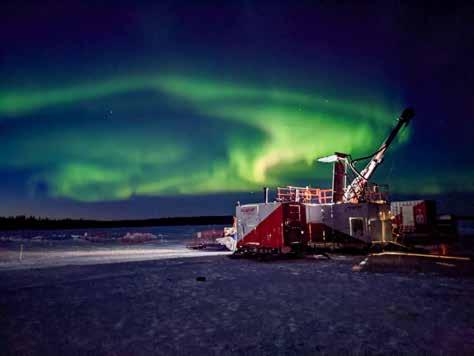


largest-ever, totaling $62 million.
Finally, Parsons states, that Lynn Lake Project fits well with Alamos’ outlook on expanding production in Canada while lowering costs.
With the development of the Lynn Lake Project, Alamos has the capacity to increase its total gold production to over 900,000 ounces per year. Initial production from the Lynn Lake Gold Project is expected as early as the second half of 2027.
Alamos’ other growth opportunity is the Puerto Del Aire Project located within the Mulatos District in Mexico. Additionally, in September 2024, Alamos published its updated guidance announcing a company-wide increase in production guidance for the years 2025 to 2026 by over 20 per cent. The increase was driven by the acquisition of Argonaut Gold’s Magino Mine located in Ontario and adjacent to Alamos’ Island Gold Mine. ✖

Grid Metals is focused on both copper/nickel and lithium projects in the Bird River Greenstone Belt, approximately 150 kilometres northeast of Winnipeg.
The MM copper/nickel project is a high-potential belt-scale copper/ nickel project with a significant resource already identified. The belt, a former nickel producer, is a direct analogue of the Ring of Fire district in northwestern Ontario, and Grid successfully consolidated all the copper/nickel deposits and occurrences in the belt in 2023. With the belt consolidation complete, Grid has taken a comprehensive view on exploration. The company plans to complete a fully funded airborne geophysics program this fall, along with a fully funded drill program to test the potential of a

four-kilometre copper trend that sits ~eight kilometres southeast of the Mayville deposit. The drill program will largely focus on the historical copper-rich New Manitoba deposit at the southeastern end of the fourkilometre trend.
Currently, the MM project captures approximately 50 million tonnes of pit-constrained copper/nickel/PGE resources. The project comprises two discrete mineral trends: (1) the Makwa Domain, which includes several nickel-rich disseminated magmatic sulfide deposits, and (2) the Mayville Domain, which hosts high tenor, copper-dominant, disseminated sulfide mineralization. The company has set the dual goals of increasing the current open pit resources to +75 Mt and adding new high-grade massive sulfide discoveries. If
successful, the project would support Manitoba’s first new critical metals mining hub in many decades.
At the Donner lithium project, an Advanced Exploration Permit has been received, subject to the posting of a reclamation bond. This will allow Grid to complete a bulk sample at site and to move quickly into full mine permitting once lithium prices recover. Grid has a lease on a gold mill within trucking distance that can be reconfigured to process lithium-bearing ore and a toll-milling agreement with the producing Tanco mine that sits 30 kilometres from our Donner lithium project.
The MM and Donner properties are in the traditional territory of the Sagkeeng First Nation, with whom Grid Metals has an exploration agreement in place. ✖
The drill program will largely focus on the historical copper-rich New Manitoba deposit at the southeastern end of the four-kilometre trend.

While “critical” or “strategic” metals like lithium and rare earth elements (REEs) have grabbed recent headlines, volatile pricing has delivered challenging markets for long term investors.
Forecasting the demand growth for these critical metals with small markets has required a bet on the success and the timing of various emerging technologies, including electric vehicles. While the importance of the energy transition hasn’t wavered, early forecasts overestimated the pace of change, such that long-term optimism for cleaner energy has not yet buoyed the subdued prices for lithium, nickel, REEs, or cobalt.
In contrast, it is easy to be consistently positive about copper, particularly when the demand and price growth is viewed over years and decades, not weeks and months. The irreplaceable role copper plays in our current energy infrastructure ensures an investment in copper is a proxy for
growing global energy demand and rising standards of living, regardless of the pace of the energy transition.
As we look ahead, the role of copper in the transition to clean energy and electric mobility cannot be overstated; solar power requires approximately five kilograms of copper per kilowatt capacity and a hybrid car around 35 kilograms. Demand for copper is estimated to grow by around 300 per cent off an already large base as the world moves towards clean energy.
Global copper discovery and development has not kept pace to meet this growing demand. The multiyear fall in equity funding for low market-cap explorers suggests the risk of a sustained copper shortfall is not close to a resolution.
North America has a long geological history that has delivered many world class copper mining districts. The need for a cleaner future, combined with a rapidly growing global population, at a time of
unprecedented geo-political uncertainty means the discovery of copper and other metals in North America has rarely been more important.
There are many companies making investments towards copper discovery and development in North America. From Arizona to Alaska and Newfoundland to British Columbia, many 10s of companies and many 100s of earth scientists are working to identify mineable projects.
T2 Metals Corp. is one of several companies active in the Flin Flon district of Manitoba and Saskatchewan – a well-endowed copper, zinc, and gold mineralized region within central Canada, with a long and rich mining history. T2 Metals’ Sherridon project, with substantial past production, historical copper resources, road and rail access, and support from the local First Nations community, is delivering key milestones following renewed and sustained investment.

As North America continues to explore and develop its copper resources, it is essential to balance economic growth with environmental sustainability. Companies like T2 Metals are taking responsible and
inclusive approaches so the region can ensure a prosperous future while protecting its natural resources.
Manitoba and Saskatchewan’s access to low carbon hydro-electric power is a great advantage for the future production of sustainable copper.
The T2 Metals team and our investors look forward to making a significant contribution to supplying metals for new energy and transport. ✖

By Jerry Asp
“We claim the sovereign right to all the country of our tribe – this country of ours which we have held intact from the encroachments of other tribes, from time immemorial, at the cost of our own blood. We have done this because our lives depended on our country. To lose it meant we would lose our means of living and therefore our lives.”
– Declaration of the Tahltan Tribe, 1910.
Situated in northwestern British Columbia, Tahltan territory extends from the Coast Mountains in the west to the lower part of the Yukon Boreal Forest in the north to the Cassiar Mountains range in the east to the headwaters of the Nass, Skeena, and the Stikine rivers in the south. As Tahltan People, we are proud, fierce defenders of our territory and resources.
What’s more, our people have always been entrepreneurs and, before contact with Europeans, we enjoyed great affluence. We capitalized on our location and established ourselves as middlemen between the Coastal and Interior Nations. Along with firs, fish, and dried berries, Tahltans traded obsidian, jade, and copper, which we mined in our territory.
The situation changed so dramatically after contact that when I started the Tahltan Nation Development Corporation (TNDC) in 1985, we had 98 per cent unemployment in the winter and 65 per cent unemployment in the summer on our reserves. Approximately 80 per cent of our members were on welfare. We also had serious alcohol and drug problems, a high suicide rate, and very low educational standards.
By 2006, things had changed for the better. We had zero per cent unemployment in the summer and five per cent in the winter. Our suicide rate dropped to zero, and we had very few people on welfare. Last year alone, we had 56 high school graduates and 18 college and university graduates. In 2019, we graduated our first mining engineer and, today, we have at least 12 students enrolled in accredited apprenticeship programs.
So how did the Tahltans return to affluence?

What made all the difference in our Nation’s return to affluence is that we developed our people along with our resources.
Back in 1988, when we negotiated our first Tahltan Participation Agreement with the Golden Bear mine, one of their representatives said to us: “We think that you Tahltans are being unreasonable.” Pat Edzerza, then Band Manager of the Iskut Tahltans, replied, “You, the resource developers, are taking away our way of life. We only ask that you replace it with something equitable. I don’t think that this is being unreasonable.”
The Tahltan Nation was able to negotiate favourable terms in that first Participation Agreement (a predecessor to the Impact Benefit Agreement) because before we even started negotiations, we set the parameters by writing the Tahltan Resource Development Policy. This Policy states:
Before a resource development project can commence within Tahltan Tribal Territory, it will be necessary for the developer and the Tahltan Tribal Council to enter into a project participation agreement that encompasses the following elements and basic principles:
1. Assurance that the development will not pose a threat of irreparable environmental damage;
2. Assurance that the development will not jeopardize, prejudice, or otherwise compromise the outstanding Tahltan aboriginal rights claim;
3. Assurance that the project will provide more positive than negative social impacts on Tahltan people;
4. Provision for the widest possible opportunity for education and direct employment-related training for Tahltan people in connection with the project;
5. Provision for the widest possible employment opportunities for Tahltan people with respect to all phases of the development;
6. Provision for substantial equity participation by Tahltans in the total project;
7. Provision for the widest possible development of Tahltan business opportunities over which the developer may have control or influence; and
8. Provision for the developer to assist the Tahltans to accomplish the objectives stated above by providing financial and managerial assistance and advice where deemed necessary.
If resource developers and the Tahltan Tribal Council can reach agreement embracing the points noted above, then we believe that Tahltans, the developers, and all other Canadians will enjoy equitable benefits from each resource development undertaken and there will be business harmony within Tahltan traditional tribal territory.
Further to this, in 2003 we held a three-day workshop on the potentials of mining in Tahltan territory. From this forum, the Tahltans developed a mining strategy:
The aim of the Tahltan Mining Strategy is to:
1. Send a signal that Tahltan people are supportive of mining and mineral activity on their land under conditions that such activities are respectful of Tahltan concerns and lead to a fair distribution of costs, benefits, and risks to implicated parties.
2. Facilitate Tahltan participation in mining and mineral activities – not only through direct and indirect employment, but also in terms of overall management/comanagement as well as the broad perspective of seeing a fair distribution (considering all participating interests) of all benefits, costs, and risks.
3. Ensure that the broad range of concerns raised in the "Seven Questions to Sustainability'' are addressed, in particular the health/social/cultural and environmental implications of mining/mineral activity; and
4. Ensure that in the future, mining and mineral activities in Tahltan Traditional Territory is a win-win for all implicated interests – the Tahltan people, mining/mineral interests, governments, and others.
Our report, “Out of Respect,” was released on January 28, 2004 at the Cordilleran Roundup in Vancouver. A full copy of this report can be found at www.iisd.org.
The importance of ensuring meaningful employment opportunities for Tahltans in mining carried out in our
territory is not always appreciated by our people. At a recent Annual General Assembly, a Tahltan member commented, “I’m not happy with the mining agreements since all we get is a few jobs.”
I checked into it and, at the time, at the Red Chris Mine alone, we had 164 employed workers. This didn’t include support workers employed by the TNDC or employment from other contractors. Workers at the Mine made an annual average wage of $80,000 to $120,000. Doing the math shows that Tahltan wages were in the $15 to $16 million range from this one project alone.
Today, the mining and exploration projects in our Territory altogether contribute approximately $30 million in wages and another $65 million in contracts annually to Tahltan members.
What brought home to me the great change that has occurred in our Nation since the early 80s was a trip taken last November by three young Tahltan women employed by the Red Chris Mine. They took a 10-day tour of Indonesia and Thailand, sending home photos every day. When they arrived back for their next two-week rotation at the mine, it was evident that they had had a great time when one of the young women commented, “I had to come back to work to rest up from my vacation.”
Why is this significant? Because had this been 1985, those same young women would probably have been stuck on the Reserve, with two to three children each, waiting for their next welfare cheque; instead, they were travelling the world with money they had earned and planning for the future on their own terms.
Lessons learned from the Tahltan experience:
1. Know what you want from a resource developer before you enter into an agreement;
2. Know what you don’t want;
3. Look to developing your people along with your resources;
4. Understand that you don’t have to accept every deal or potential opportunity that comes along; and
5. Use top professionals that you can trust as your advisors, including lawyers, accountants, and engineers.
It is not a great mystery how the Tahltan Nation retook control over its land and resources – it was a step-by-step process. And if the Tahltans can do it, any Indigenous Nation can do it. ✖
By Wendy King
A high school shop class was not a place Shianne Pineda particularly wanted to be, but she could never have guessed the compulsory course would be the first step on an unexpected journey to a career in the Red Seal trades. But with time – and encouragement – she discovered her destination.
“I hated it at first, and then I just gradually got better,” said Pineda, now 23. “The teachers saw a lot of potential in me and they're like – you can come
take my job. They saw what I didn't see.”
Pineda took the leap and committed to completing her training as a welder.
“Becoming a Red Seal… It's a bragging point for my mom. She loves telling everyone and anyone that I'm a Red Seal welder,” she said.
Working in traditionally maledominated trades, Pineda says that learning to be tough and knowing that men and women communicate
differently is part of the learning curve.
“Just don't take anything to heart –that's how I overcome it. They mean well, even though they're not saying it well,” she added.
Red Seal trades are demanding and mean shift work, but balance is possible.
“Just try to keep yourself active and interact with as many people as you can – it balances out,” she said. “This is the way I look at it – this is for my


















future. I won't be on this shift forever. I’ve just got to get through the rough times so I can have a better future.”
Pineda encourages interested women to pursue the Red Seal trades. She says overcoming inherent challenges is worth it. Good mentors can help get you there.
“My welding instructor was male, and he was like, ‘Go kick some butt!’ He never discouraged me, even when I had a hard time,” she said.
Encouragement can be as simple as the instructor saying, “you’re a good welder.”
Pineda says communication is a key skill for success in the trades.
“There are a lot of things you have to ask about. It’s just having the confidence to ask and get reassurance you're doing everything right,” she added.
Some women may find working primarily with men to be intimidating, even fearing potential harassment.
“Yes, you have to deal with that,” she said. “But also, you meet really good people – people who respect what you do.”

The Red Seal trades offer a bright future for women. Even after certification, Red Seal trades are a place to continually hone valuable skills and grow as a professional.
“I would like to be a supervisor,” Pineda said. “So, I'm trying to keep pushing, and keep learning. What I've learned from my achievements is that if I put my mind to it, nothing can stop me.”
The First Peoples Development Inc.’s LauncHER into Trades project is geared to help women apprentices in Manitoba navigate challenges that may impact progression in attaining a journey-person designation in a Red Seal trade.
LauncHER provides tailored support, resources, and mentorship to women such as Shianne. The project will follow and guide women on their journey to success.
It will also assist employers in providing support to the women apprentices on their team. By embracing equity and inclusion, companies entice valuable, skilled workers to their workplaces.
To learn more about the LauncHER into Trades project or other FPDI initiatives, call 204-987-9570 or visit www.fpdinc.ca. ✖



nrtinquiry@nrtlp.com
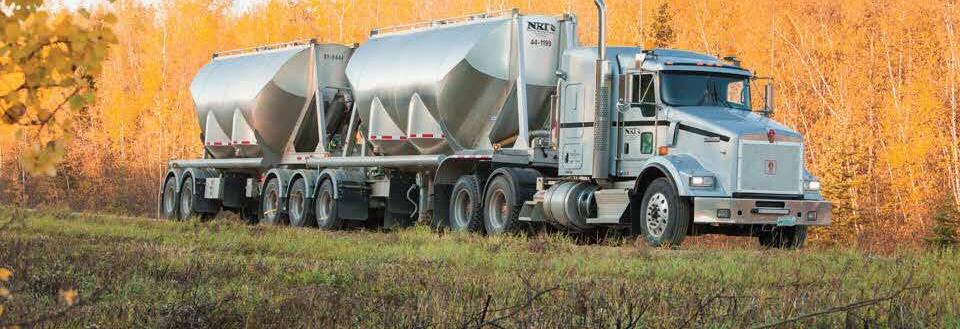
235-4013
In the mining industry, particularly in remote regions like northern Manitoba and Ontario, aviation is a critical link that ensures operations run smoothly. With limited road access, minimal infrastructure, and harsh environments, many industries like mining rely on innovative transportation solutions to move both crews and cargo. For over 60 years, Perimeter Aviation and its eastern division, Bearskin Airlines, have played a pivotal role in supporting mining operations through customized charter services and cargo transport to remote locations.
Perimeter Aviation's fleet of over 40 aircrafts is designed to handle the unique challenges of northern travel, from gravel airstrips to extreme weather conditions. As demand for access to remote mining sites increases, Perimeter continues to be the logistical backbone, offering timely and efficient solutions for crew rotations, freight transport, and other essential services.
Perimeter Aviation understands the value of collaboration, not just with industry leaders but also with the communities it serves. The company has forged partnerships with Indigenous communities, working to provide opportunities that benefit local economies and foster cultural connections. By integrating Indigenous perspectives into its operations, Perimeter reinforces its belief in connecting people – across cultures, communities, and industries.
Perimeter views itself not only as a transportation provider but as a business solutions partner. Through customized services, the airline enables companies to focus on their core operations, offering flexible scheduling and rapid response to evolving industry needs.
In mining, time is money, and efficiently transporting crews and supplies can make or break an operation. Many remote mining sites lack road infrastructure, making air travel the most reliable option. Perimeter’s specialized charter services give customers the flexibility to set their schedules, streamline crew rotations, and minimize downtime.
“Aviation is indispensable to the mining industry,” said Joey Petrisor, CEO of Perimeter Aviation. “Our fleet connects mining companies with resources essential to their operations, delivering safe and efficient travel to even the most remote locations.”
Perimeter’s deep understanding of the mining sector allows it to provide customized solutions that evolve with the industry's needs. From last-minute transport requests to managing complex logistics, Perimeter has become a trusted partner in mining and beyond.
As demand for passenger and freight services grows, Perimeter is set to unveil its newly expanded terminal in February 2025. The development will enhance Perimeter’s ability to serve passengers with upgraded facilities, including modern amenities, larger waiting areas, and streamlined logistics, designed to reduce wait times and improve cargo flow.
“Our terminal expansion is a reflection of our commitment to the passengers, communities, and industries we serve,” said Petrisor. “We’re excited to offer improved facilities and a best-in-class northern travel experience.”
With its expanded terminal and versatile fleet, Perimeter is positioned to be the leader of northern travel. By providing tailored solutions for scheduled flights, charters, and freight, the company ensures that clients in industries like mining can rely on their expertise.
“We offer more than just transportation – we offer peace of mind,” said Petrisor. “Our clients can focus on their operations, knowing their travel needs are handled by experts.”
Perimeter Aviation’s ongoing innovation, adaptability, and commitment to connecting communities ensures it will remain a key player in Canada’s mining success, fostering growth and cultural exchange in the northern regions it serves. ✖

By Rob Carter, Vice President, Manitoba Business Unit at Hudbay Minerals Inc.
In 2027, Hudbay will celebrate 100 years since our founding in Flin Flon. Man., which remains a core part of our journey and long-term success. As we approach this significant milestone, we remain committed to Manitoba, investing in the region to drive future success.
The New Britannia mill has been critical to our success in the province, consistently exceeding expectations. The mill continues to outperform this year, supporting higher gold production in this favourable gold price environment. By optimizing our processes and focusing on preventative maintenance, we’ve advanced the mill’s performance beyond its initial design, allowing us to maximize output. Following the refurbishment of the New Britannia mill and enhanced operating efficiencies at the Lalor mine, we expect annual gold production of 185,000 ounces over the next three years. We also received permit approval to increase mill capacity to handle more gold ore from our Lalor mine and create latitude for future regional discoveries. These advancements help illustrate our
commitment to sustaining and growing our operations in the area while meeting the demand for metals.
Beyond operational efficiencies, we’re always considering new opportunities to strengthen stakeholder value through our commitment to exploration, innovation, and strategic partnerships. Recent exploration efforts have been extremely promising, particularly around the Lalor Northwest area, where follow-up drilling confirmed two new mineralized zones located within 400 metres of our existing underground infrastructure. Our summer drill program shows strong potential, and with multiple drill rigs currently operating in the area, we anticipate further positive results in the coming months.
Earlier this year, we launched our most extensive ground geophysics program, which has yielded several exciting targets across our newly acquired land package in Snow Lake. Our cutting-edge geophysical techniques help us detect deeper anomalies, and many of our new land claims have been untested by modern geophysics. We
are optimistic about these findings and their potential to uncover new anchor deposits within reach of our existing processing facilities and further grow our long-term operations in Snow Lake.
Our team’s innovative approach has improved deposition efficiency at the Anderson tailings facility with new equipment and improved procedures allowing us to defer dam construction costs to future years. We have received permit approval from Manitoba Environment and Climate Change for a three-year subaerial tailings deposition trial, which is underway.
We are developing an access drift to the 1901 deposit from the Lalor ramp this year, which is on track to reach mineralization in early 2025. At that time, we will conduct definition drilling to refine mining methods and evaluate the orebody, aiming to convert additional gold resources into reserves. Pending positive results, we expect to initiate further development in 2025 and 2026, with full production at 1901 anticipated by 2027.
Sustainability and environmental stewardship are central to our operations. In 2024, we set targets to minimize our impact and developed an emissions reduction plan for our Manitoba operations. We’ve reduced propane and diesel consumption and recycle natural groundwater at Lalor to decrease our freshwater use.
Safety also remains a cornerstone of our success. Last year, we launched the “Home Safe Every Day” program to enhance crew safety through proactive measures and ongoing team engagement. By focusing on critical controls, leading indicators, and refining our safety processes, we drive improvements beyond meeting targets, fostering a culture where safety is deeply embedded in everything we do.
As we look ahead, Hudbay remains dedicated to our projects in northern Manitoba, producing the essential metals needed for clean energy technologies, and creating growth and prosperity for all our stakeholders. With a focus on innovation and progress, we are building on our legacy, contributing to a sustainable future. ✖
At Hudbay, our mission extends beyond mining — we’re shaping a more sustainable future.



Our company-wide commitments include reducing greenhouse gas (GHG) emissions by 50% by 2030 and achieving net-zero by 2050.
Our Manitoba Business Unit is leading the charge in sustainable practices, implementing innovations like batteryelectric equipment and achieving significant reductions in emissions and freshwater usage.
With nearly 100% of our total indirect energy in Manitoba coming from renewable sources, we continue to pioneer responsible mining, evaluating reprocessing tailings to recover critical minerals, and reducing our environmental footprint.
Through these efforts, we ensure that our operations contribute to a greener economy while safeguarding the communities and environments where we operate.


From powering pneumatic tools to conveying materials through pipes, compressed air systems play an important role in manufacturing operations. The versatility and practicality of these systems has made them a popular technology in industrial facilities of all sizes.
However, there is one potential disadvantage – they can be incredibly energy intensive. On average, 10 per cent of most industrial energy costs are related to the electricity required to run compressed air systems. The costs associated with any inefficiencies can be difficult to manage, from increased monthly energy bills to higher operating and maintenance costs. Leaks are a common culprit; they can represent 30 per cent of compressed air loads when not managed properly. Whether it’s properly sizing the system, identifying and eliminating leaks, maintaining and monitoring the system, or replacing it altogether, taking appropriate action now can lead to long-term energy savings and benefits. Luckily, Efficiency Manitoba can make the process straightforward and more affordable.
Efficiency Manitoba helps mineral and mining operations make improvements to their compressed air systems by providing technical support and financial incentives. Their variety of offers can facilitate the assessment and proper sizing of new equipment, as well as the maintenance of your systems for optimal use.
Efficiency Manitoba can conduct a free benchmark study on your system to identify energy-saving opportunities. After a compressed air contractor gathers baseline data of your existing system, Efficiency Manitoba’s technical experts will analyze the data and prepare a benchmark study that can aid in properly sizing replacement equipment, identifying other areas for improvement, and estimating energy savings.
Efficiency Manitoba can also offset your capital investment with performance-based incentives through their Custom Energy Solutions Program. The greater the energy reduction, the higher the incentive. Their network of experienced contractors will work with customers to implement these upgrades.
If a capital upgrade isn’t in your budget, Efficiency Manitoba also supports energy waste reductions by addressing leaks in compressed air systems. Leak audits are an effective way to maintain and optimize your system by reducing wasted energy, minimizing unnecessary wear, and preventing operational downtime.
Buffalo Creek Mills, an oat ingredient producer of highquality ingredients suitable for human consumption, pet food, and feed markets, works in partnership with local farmers, as well as buyers and distributors from Manitoba and around the world. This Altona-based business is
growing rapidly, leading to increased production needs.
“As we were preparing for an expansion, our production facility’s existing compressed air system needed to be upgraded to increase its supply capacity,” said Phil Carriere, director of operations at Buffalo Creek Mills.
With assistance from Efficiency Manitoba, Buffalo Creek Mills was able to upgrade their compressed air system. The project started with their contractor, Air Unlimited, performing a baseline logging of their existing compressed air system. The industrial systems engineer at Efficiency Manitoba analyzed the data and prepared a benchmark study. The facility then began exploring options to optimize their compressed air system, which ultimately led to installing a new higher-efficiency compressor, a heated blower desiccant dryer with dewpoint control, oversized filters, a central regulator, and two 660-gallon storage tanks.
“We’ve already seen a difference in our energy use with these upgrades,” Carriere said. “Efficiency Manitoba estimated we’d save 356,000 kWh in electricity and $23,200

on our energy bills annually, which are huge savings for us.”
These savings meant Buffalo Creek Mills received an incentive of over $41,000 from Efficiency Manitoba.
“The financial and technical support Efficiency Manitoba provides through their programs was instrumental in us identifying potential improvements and designing efficient solutions for the customer,” said Juan Londono, applications engineer at Air Unlimited. “We knew that system control was a potential issue, and efficiency and reliability were top priorities with the new system at Buffalo Creek Mills. Efficiency Manitoba was a big help in modelling the overall system reliability and energy usage. Their modelling helped to confirm that our approach for setting up the system would ensure it runs at the highest efficiency for the customer.”
Efficiency Manitoba is committed to providing industrial customers with incentives and technical support to help make your operations more energy efficient. To learn more, visit www.efficiencyMB.ca/industrial. ✖
When time is money, trust Perimeter Aviation to keep your mining operations moving. With over 60 years of experience and a fleet of over 40 aircraft, we provide reliable, flexible charter and scheduled passenger services to remote locations across Manitoba and Northern Ontario. Whether it’s crew rotations, equipment transport, or urgent deliveries, we can provide customized options to meet your needs.
Contact our dedicated team today, to learn why we’re your trusted partner.

“Your project. Our expertise. Common ground” is a tagline that has accompanied Dumas from the heights of the Peruvian Andes to the depths of the Canadian Shield. Round-by-round we have undertaken some of the most technically challenging and complex underground mining construction scopes of work for the very best mining companies in the world.
From our humble beginnings in northern Ontario to becoming a mining contractor of choice for major mining companies across the Americas, Dumas’ vision of customer satisfaction and zero harm permeates our operations and has guided us through 30 years of sustained underground operations.
Dumas Contracting Ltd. was founded by brothers Daniel and Marc Dumas in 1994 and is now a proud member of the STRACON Group. Dumas’ early successes were forged on the blossoming narrow-vein gold mines situated along the legendary Porcupine-Destor fault throughout the Timmins – Val D’or corridor. The early years focused on supporting the legacy mining operations in the Abitibi region, such as Placer Dome’s flagship operations in Timmins, designing and building mine access infrastructure in new underground projects, like the Hoyle Pond mine, and expanding the smaller regional gold mines, such as Eagle River, to unlock their production potential. In subsequent years, Dumas expanded from its strong base in northern Ontario to other regions in Canada and into the United States, Mexico, Chile, Guatemala, and Peru.
Dumas’ Manitoba story begins at Bucko mine in 2007. Dumas was contracted to dewater the legacy shaft and initiate development of a new portal and decline ramp to connect with the shaft. Dumas successfully completed the breakthrough and over 2200 metres of development at the project between 2007 and 2010. The company continued to
grow in the region with a large-scale shaft sinking project at Hudbay Minerals Lalor Mine located in Snow Lake in 2011. Dumas’ crews sunk a 6.7 metre diameter concrete lined shaft to a final depth of 1,000 metres, which was completed in 2014. Dumas returned to the Lalor site in 2016 to undertake Development Mining Services for Lalor Mine and have remained an active partner to this day.
Dumas has been dedicated to fostering sustainable partnerships with Indigenous partners and communities, recognizing the importance of respecting traditional lands and incorporating local knowledge into their operations. By prioritizing meaningful consultation and joint decisionmaking, Dumas ensures that its mining practices not only support economic development, but also uphold cultural heritage and promote mutual benefits. Throughout its 17 years of operating in Manitoba, Dumas has hosted training programs in partnership with local Indigenous communities, supported recreational activities, and helped improve infrastructure in the region. An example of this is the outdoor rink in Snow Lake, which Dumas employees working in the area took the initiative to upgrade and repair the facility with local partners to allow the community to enjoy this asset for many years to come.
One of the most important factors contributing to Dumas’ growth and success over the past 30 years is our exceptional employees across the Americas, both past and present. Our people are our most important asset. From regional office employees to our remote workers in the field, dedication to safety and teamwork has grown Dumas into the company we are today. We have a reputation of being hard workers who collaborate with our clients to achieve success for all.
We look forward to the next 30 years of growth in underground mining! ✖

‘IT’S

Vale Base Metals’ Manitoba Operations have been mining high-grade nickel sulfide ore in Thompson for nearly 70 years, and the operation’s team is busy laying the groundwork for another 70 years of mining in northern Manitoba.
“It’s an exciting time for mining in Thompson and Manitoba. We’re making big investments in our operation, and making new discoveries in our region, while making mining more welcoming and accessible to everyone,” said Stacy Kennedy, Director of Manitoba Operations for Vale Base Metals.
Vale Base Metals is one of the world’s largest producers of high-quality nickel and an important producer of copper and responsibly sourced cobalt, with operations in Manitoba, Newfoundland and Labrador, Ontario, Indonesia, Brazil, the United Kingdom, and Japan. Its
By Kelsey James

mission is to safely deliver the critical minerals essential to the world’s energy transition, while improving life and transforming the future.
In Thompson, the company currently operates two underground mines, T1 and T3, which feed ore to a concentrator that prepares it for shipping and further processing in Ontario.
Vale Base Metals aims to be a leader in environmentally responsible and sustainable mining. Last year, Vale’s operations, including those in Manitoba, met a big milestone when they became ISO 14001:2015 certified, meaning they meet the international standard for industrial environmental management.
Thompson’s environmental management strategy includes
proactively remediating and re-using waste materials from mining to reduce its footprint and its costs, as well as a robust water quality management system.
“We take our responsibility for our watershed seriously,” Kennedy said. “Every step to make sure the water that flows through our property goes back into the environment as clean as it came in.”
One of Thompson’s major growth projects has been the Thompson Mine Extension Project, a $150 million investment in the future of Thompson’s T3 mine. The electrical, mechanical, and ventilation upgrades will help them improve production in the most active areas of the mine and build the business case for much larger investments.
But Thompson’s exploration team is also looking beyond its main mine sites, executing on an ambitious exploration campaign to learn more about the opportunities in the broader region surrounding Thompson.
“The Thompson Nickel Belt has been mapped extensively closer to the surface,” Kennedy said. “But there’s more to be discovered at depth. We’re investing heavily into expanding our knowledge of very promising orebodies in the area, with a lot of promising results.”
One of the operation’s biggest priorities is to grow its local workforce and make sure northern Manitobans have an opportunity to benefit from the wealth that mining creates. Vale Base Metals is Thompson’s biggest single employer, directly employing more than 700 people along with the contractors and vendors that support the operation. In Manitoba alone, Vale contributed $271 million in labour income over the last three years, and their average salary is more than double the provincial average.
“We have great, lifelong opportunities in mining,” Kennedy said. “Lots of our leaders here started underground as miners and built amazing careers. A job in mining can be a life-changing opportunity.”
Last year, Manitoba launched its Miners in Training curriculum, now called the Next Generation program. The program offers six weeks of training in Vale’s dedicated underground training area, helping new hires with no industrial or mining experience build a foundation for a safe and successful career as underground miners, with a particular focus on women entering the industry.
Hiring events like Walk-in Wednesday also help open the industry to a variety
of local candidates, where anyone could come in off of the street, resume in hand, and interview with one of the operation’s hiring managers.
“It means that anyone with the drive to try something new has the chance to build a life with us,” Kennedy said.
Thompson, known as the “Hub of the North,” is named after John F. Thompson, chairman of International Nickel (INCO). The company discovered its main ore body in 1956 and, from there, operations and the rest of the community grew around that finding. You can still see signs of Thompson’s mining heritage throughout the community, and continues to plays a big role in community life. The operation invested nearly $750,000 into community initiatives last year, including part of a $2 million investment over four years towards Thompson’s new aquatic facility.
“We’re really privileged to have great relationships with our local government, with recreational clubs and community groups, and with our Indigenous partners in Thompson,”
Kennedy said. “Most of our employees live and work in Thompson, and I’m proud to see how much they’re engaged with community life. You can find our employees leading helping out everywhere in the community.”
Now, Kennedy and the Manitoba team are working to honour the Indigenous heritage of Thompson, and the Treaty 5 territory where they operate. This year, Vale Base Metals signed a new exploration agreement with the neighbouring Nisichawayasihk Cree Nation, creating a mutually beneficial relationship with the community and the company’s exploration program – one that commits to a larger relationship agreement in the future.
“Mining has a big role to play in reconciliation in Manitoba,” Kennedy said. “This is a historic agreement, and long overdue.”
For more information about Val Base Metals and the company’s Thompson operations, visit www.vale.com/basemetals, or read it’s Journey Together community reports at www.vale.com/journey-together-reports. ✖

Core Nickel
Critical Discoveries
Hudbay Minerals Inc
0905144 B C Ltd
1000078824 ONTARIO INC
10059846 Manitoba Ltd
1911 Gold Corporation
4058667 MANITOBA LTD
55 North Mining Inc.
5918139 MANITOBA INC
7268425 Manitoba Limited
A SEDLEY (BOB) TURNER
ACME Lithium
Adia Resources Inc
Altius Royalty Corporation
Amyotte, Ethan
AURIGA GOLD CORP
Avignon Resources Pty Ltd
Bashaev, Svetlana
Big Ridge Gold Corp
Bishopsgate Exploration Ltd
Bullrun Capital
BWR Exploration Inc.
Callinex Mines Inc
CanAlaska Uranium Ltd
Canickel Mining Limited
CanMine Resources Corporation
CanWhite Sands Corp
Carlisle Goldfields Limited
CBSGeoscience
Clark, Scott
Coltan Mines Limited
Dave Meek
DLM Gold Ventures Inc
Drysdale, Jonathan
Dusessoy, William
Dysart, Samuel
Eden Gold Corporation
Fawley, Kevin
Foremost Lithium Resource and Technology
Fowler, Brian
Mount Morgan Resources Ltd.
Satori Resources Inc
Strider Resources Limited
Francois Leighton, Andre
Garry Thorne
George M Nykulaik
Glenn Eisbrenner
Global Nickel Inc
Golden Pocket Resources Ltd
Goldpath Resources Corp
Gossan Resources Limited
Grandview Gold Inc
Grid Metals Corp
Halo Resources Ltd
Harley Spence Davy
Harold Westdal
Hartley, Michael
HD Minerals Ltd
Ian Scarth
James Cruise Campbell
K2 Resources Inc
Kenneth Marlin Klyne
Kenorland Mineral Inc
Kenorland Minerals North America Ltd
KG Exploration (Canada) Inc
KoBold TNB Holdings, Inc
Lakewinn Resources Corp
Le Léannec, Luc
Leeuwin Metals Canada Ltd
Linklater, Jody
Linrose Expert Travel
Lithium Canada Development Inc
Lithtoba Resource Inc
Lodestar Battery Metals Corp
Lotz, Jason Lytwyn, Chris
Maskwa Nickel Chrome Mines Limited
Mathur, Shilika
McDondald, Richard
Metal Energy Corp
Mid-Canada Alliance
Minnova Corp
Mumin, Rashid
NiCan Limited
Nikolay Bashaev
Opekar, Margaret
Ozias Theriault
Peter C Dunlop
PFS Interpretations Ltd
Qmc Quantum Minerals Corp
Reliance Minerals Ltd
Richard H Masson
Shaun Spelliscy
Silex
Snow Lake (Crowduck) Ltd
Softrock Minerals Ltd
Stephen J Lesavage
StOnge, Andre
T2 Metals Corp
Tantalum Mining Corporation of Canada Limited
Tasic Graphite Ltd
Tiberius Gold Corp
Torch River Resources Ltd
Tourigny, Ryan
Trevali Mining (Maritimes) Ltd
Vale Canada Limited
Vanadian Energy Corporation
Vision Lithium Inc
VMS Ventures Inc
Voyageur Mineral Explorers Corp
W S Ferreira LtdTD
Wiebe, Ronald
Willeson Metals Corp
William C. Hood
Wolfden Resources Corporation
Wynex Resources Inc
Yamana Gold Ontario Inc
Core Nickel
1155327 B C Ltd
Adams, Ronald
Adia Resources Inc.
Anglo American Exploration (CANADA) Ltd
Avignon Resources Pty Ltd
Big Ridge Gold Corp
Boliden Mineral Canada Ltd
Brunswick Exploration Inc.
BWR Exploration Inc
Callinex Mines Inc
CanAlaska Uranium Ltd
Conduit Nickel Inc
Hudbay Minerals Inc.
Core Nickel
DG Resource Management Ltd
Ernie Guiboche
Exiro Minerals Corporation
Fortescue Canada Ltd
Garry Thorne
Grid Metals Corp
Hudbay Minerals Inc.
Integral Metals Corp
Jayden Resources Inc
Kenorland Minerals North America Ltd
Kopore (WA) Pty Ltd
1911 Gold Corporation
5918139 MANITOBA INC
ATOMIC ENERGY OF CANADA
Callinex Mines Inc
Canickel Mining Limited
Carlisle Goldfields Limited
Coltan Mines Limited
Core Nickel
Flying Nickel Mining Corp.
Global Nickel Inc
Leeuwin Metals Canada Ltd
Lithium Bouvier Inc
Lithium Canada Development Inc.
Poehlman, Tania
Qmc Quantum Minerals Corp
Shaun Spelliscy
Stuart Deveau
Stuhini Exploration Ltd.
Superior Nickel Inc
Vision Lithium Inc
Wolfden Resources Corporation
Yamana Gold Ontario Inc
Golden Pocket Resources Ltd
Halo Resources Ltd.
HD Minerals Ltd
Hudbay Minerals Inc
McFarlane Lake Mining Incorporated
Minnova Corp.
PADCOM
Tantalum Mining Corporation of Canada
VALE Canada Limited
Voyageur Mineral Explorers Corp


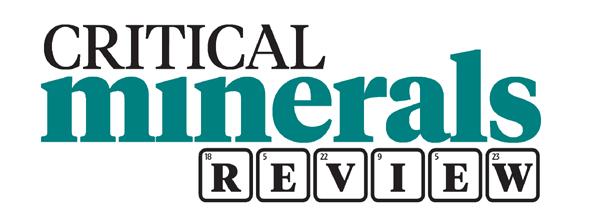


Don’t miss the world’s premier mineral exploration and mining convention
2-5 5
PROSPECTORS & DEVELOPERS ASSOCIATION OF CANADA

Up to 30,0 00 attendees 700+ hours of programming
1,100+ exhibitors Delegates from 130+ countries
Meet investors & senior execut ives Unrivaled networking pdac.ca/convention | Toronto, Canada


